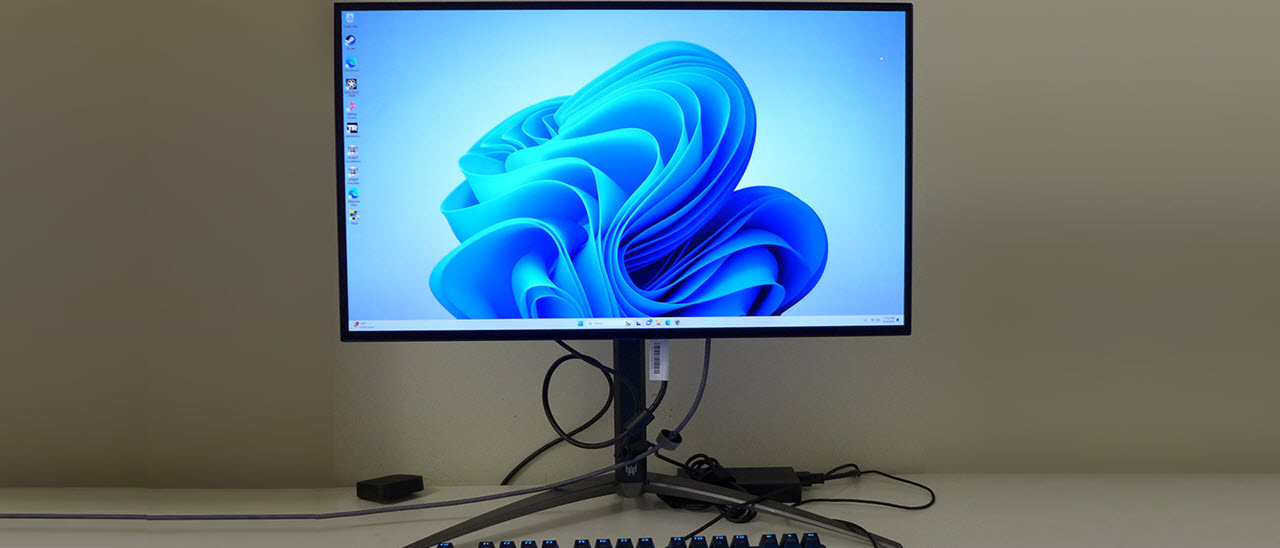Why you can trust Tom's Hardware
To read about our monitor tests in-depth, please check out Display Testing Explained: How We Test PC Monitors. We cover brightness and contrast testing on page two.
Uncalibrated – Maximum Backlight Level
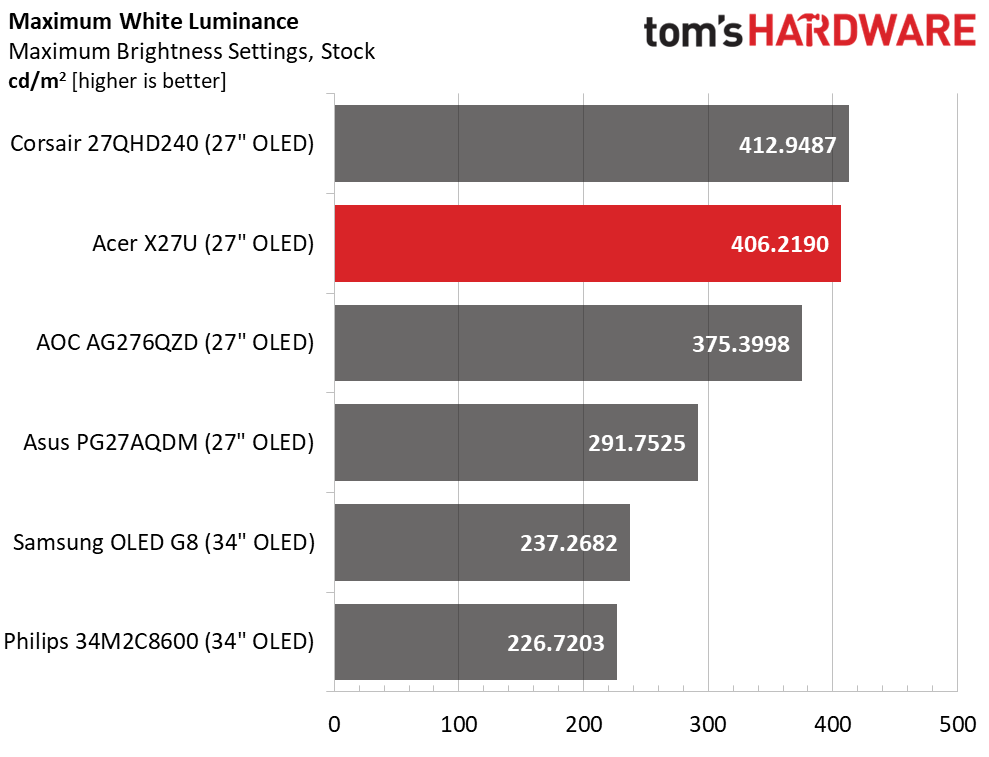
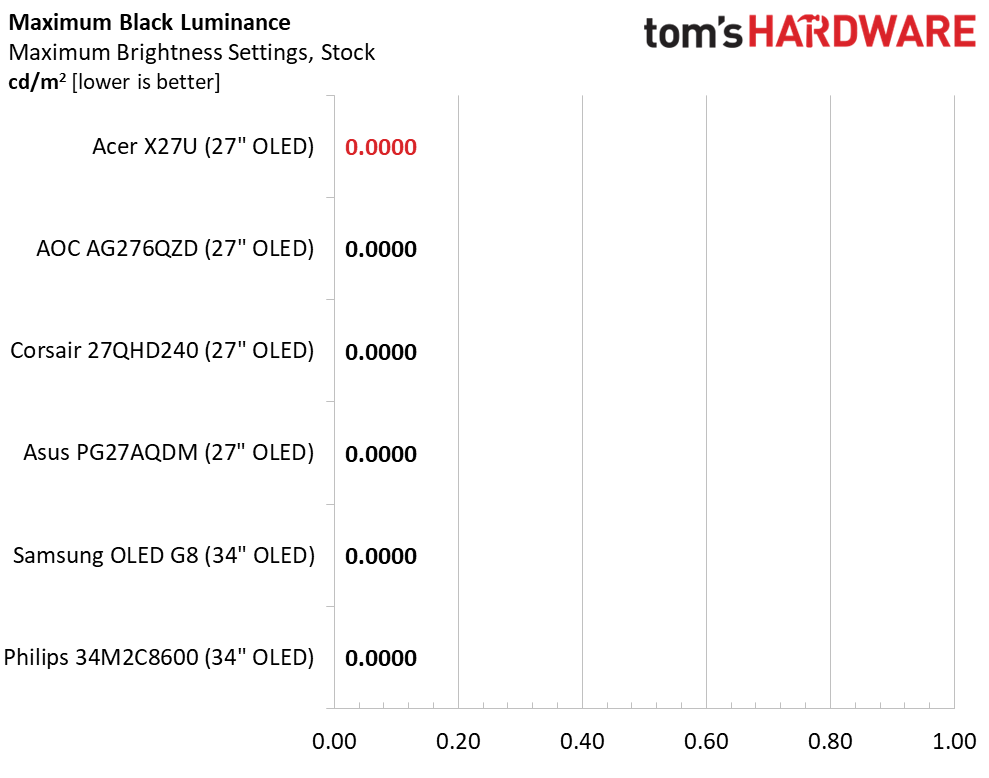
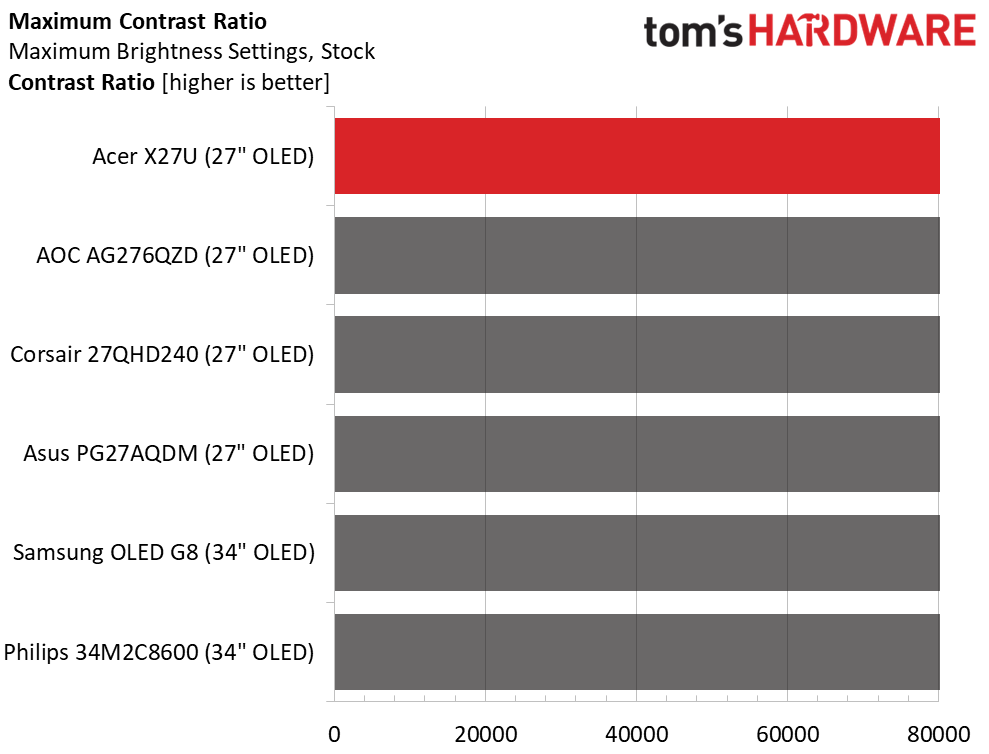
To explore the X27U’a maximum potential, I left Constant Brightness off. Turning it on limits brightness to around 150 nits. The contrast is still there, but it will only look good in a dark room. I measured 25% window patterns for all tests.
Peak brightness was over 406 nits, more than enough output for any indoor situation. While this seems very bright, it is manageable in practice. Bright images are not harsh or fatiguing in any way. Since there is no way to measure OLED black levels, all the screens have theoretically infinite contrast. Scientifically, it is unmeasurable contrast.
After Calibration to 200 nits

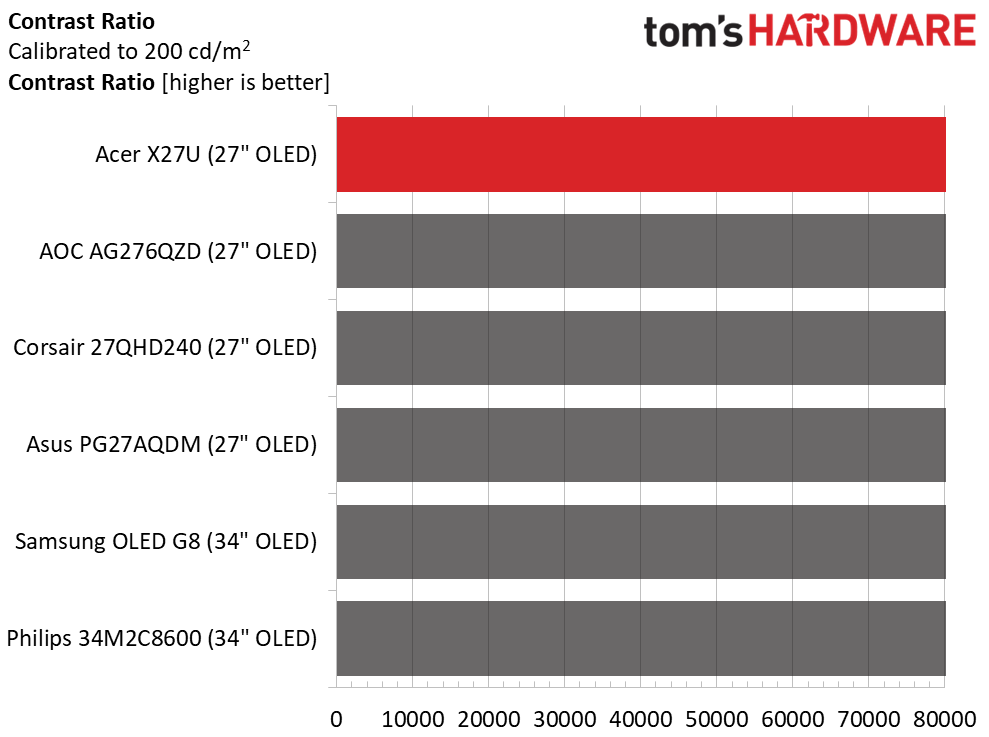
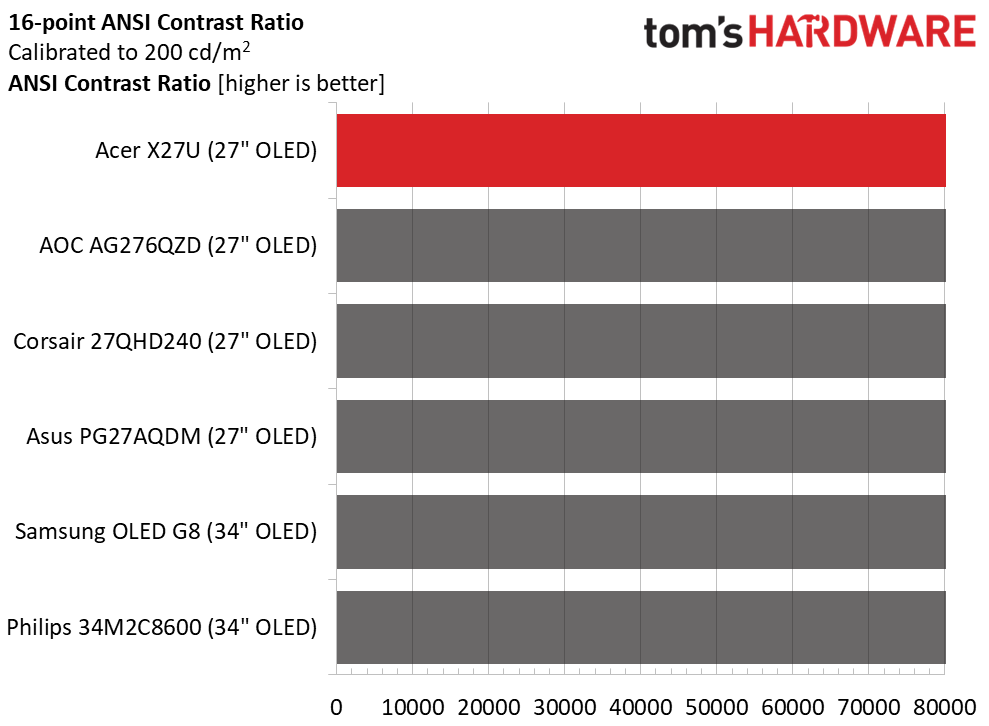
For testing consistency, I adjusted the X27U to 200 nits based on the same 25% window pattern. You can turn the brightness higher than this, depending on your usage environment. Again, there are no measurable black levels, so contrast is also unmeasurable. The ANSI test yields the same result. The black squares of the checkerboard pattern have no detectable light.
Test Takeaway: OLEDs look strikingly different from LCDs thanks to their black levels and massive dynamic range. This increases perceived resolution and makes color look more saturated. As you’ll see on the next page, the X27U's color is more saturated. This is why you buy an OLED.
MORE: Best Gaming Monitors
MORE: How We Test PC Monitors
Get Tom's Hardware's best news and in-depth reviews, straight to your inbox.
MORE: How to Buy a PC Monitor
MORE: How to Choose the Best HDR Monitor
Current page: Brightness and Contrast
Prev Page Response, Input Lag, Viewing Angles and Uniformity Next Page Grayscale, Gamma and Color
Christian Eberle is a Contributing Editor for Tom's Hardware US. He's a veteran reviewer of A/V equipment, specializing in monitors. Christian began his obsession with tech when he built his first PC in 1991, a 286 running DOS 3.0 at a blazing 12MHz. In 2006, he undertook training from the Imaging Science Foundation in video calibration and testing and thus started a passion for precise imaging that persists to this day. He is also a professional musician with a degree from the New England Conservatory as a classical bassoonist which he used to good effect as a performer with the West Point Army Band from 1987 to 2013. He enjoys watching movies and listening to high-end audio in his custom-built home theater and can be seen riding trails near his home on a race-ready ICE VTX recumbent trike. Christian enjoys the endless summer in Florida where he lives with his wife and Chihuahua and plays with orchestras around the state.
-
gg83 Thank you so much for this review and calibration recommendation! I bought this monitor a few months ago. I have been using amd adrenaline to adjust color hue and whatnot. I have it set per game so maybe I won't have to do that anymore.Reply -
Perosteck I can't see that this has G-Sync anywhere on the product specs online, or on the Asus website. Is this correct?Reply -
Order 66 um, anyone notice how it says DisplayHDR 400 certification when the measured HDR brightness is 600 nits? does that seem strange to anyone else? I'm also confused on why this monitor has two different HDR certifications. If it has HDR 10 and can reach 1000 nits, then why only DisplayHDR400?Reply -
parkerthon So… I scrolled this article which is brimming with praise, but nothing about burn in for people that run windows for productivity all day? I understand it’s a flaw of all oled but it’s still worth calling out. Asus has no burn-in protection apparently. Also it’s woled so text clarity presumably sucks. Will continue to wait patiently for a technological miracle that solves these two issues I guess. Also hdr support for games is still awful. At ~$700 for a 27” monitor you’d ideally use ONLY for gaming on a few select titles that really embrace hdr… bit much. Really hoping mini-led eventually comes along. I don’t need pure blacks, just something that’s not a gray white glow.Reply -
UnforcedERROR Reply
Mini-LED already exists in monitors (this article even notes the alternative version was prior to this OLED), and they're appreciably cheaper in most cases. The AOC Q27G3XMN and KTC M27T20/Cooler Master GP27Q are all decent. The AOC isn't even $300, and the KTC can be about $330 if you find a coupon. HDR is good for movies too, but I'd never recommend a monitor for that over a good TV.parkerthon said:Really hoping mini-led eventually comes along. I don’t need pure blacks, just something that’s not a gray white glow.
You're misunderstanding the certifications. HDR10 is a static metadata certification mainly used in film and TV. It can be mastered up to 4,000 nits, but largely aims for 1,000. A TV/monitor doesn't have to hit 1,000 nits to get HDR10 certified, and most content isn't mastered that bright anyway. Presumably HDR600 should be applicable here, but I suppose they decided to play it safe. HDR400/600/1000 is a VESA standard for monitors, unlike HDR10 which is more about decoding the HDR10 signal.Order 66 said:um, anyone notice how it says DisplayHDR 400 certification when the measured HDR brightness is 600 nits? does that seem strange to anyone else? I'm also confused on why this monitor has two different HDR certifications. If it has HDR 10 and can reach 1000 nits, then why only DisplayHDR400?
Also OLEDs are notably less bright than mini-LED. Some newer models can hit a peak brightness of over 1,000 nits in highlight tests, but full screen brightness is often far less. As an example, the Sony A95L has a peak highlight of 1,350 nits. A TCL QM8? 2,500, and in some cases read up to 3,000+. Peak brightness on that A95L is like 300 nits though, so it's all relative. -
Order 66 Reply
I have this monitor and it’s great. It gets extremely bright. If I wasn’t so concerned about OLED burn in, I would’ve gotten the x27uUnforcedERROR said:The AOC Q27G3XMN -
UnforcedERROR Reply
Yup! I went the same route for the same reasons. Micro-LED is probably going to be the best option once it scales down, but that's a few years out still.Order 66 said:I have this monitor and it’s great. It gets extremely bright. If I wasn’t so concerned about OLED burn in, I would’ve gotten the x27u -
icycool Christian, I am not reading your reviews anymore.Reply
You fail to be up front about the panel used. QD-OLED is vastly different from WOLED.
You never mention text clarity. Something people actually care about.
See TFTCentral on how to do a proper monitor review.
